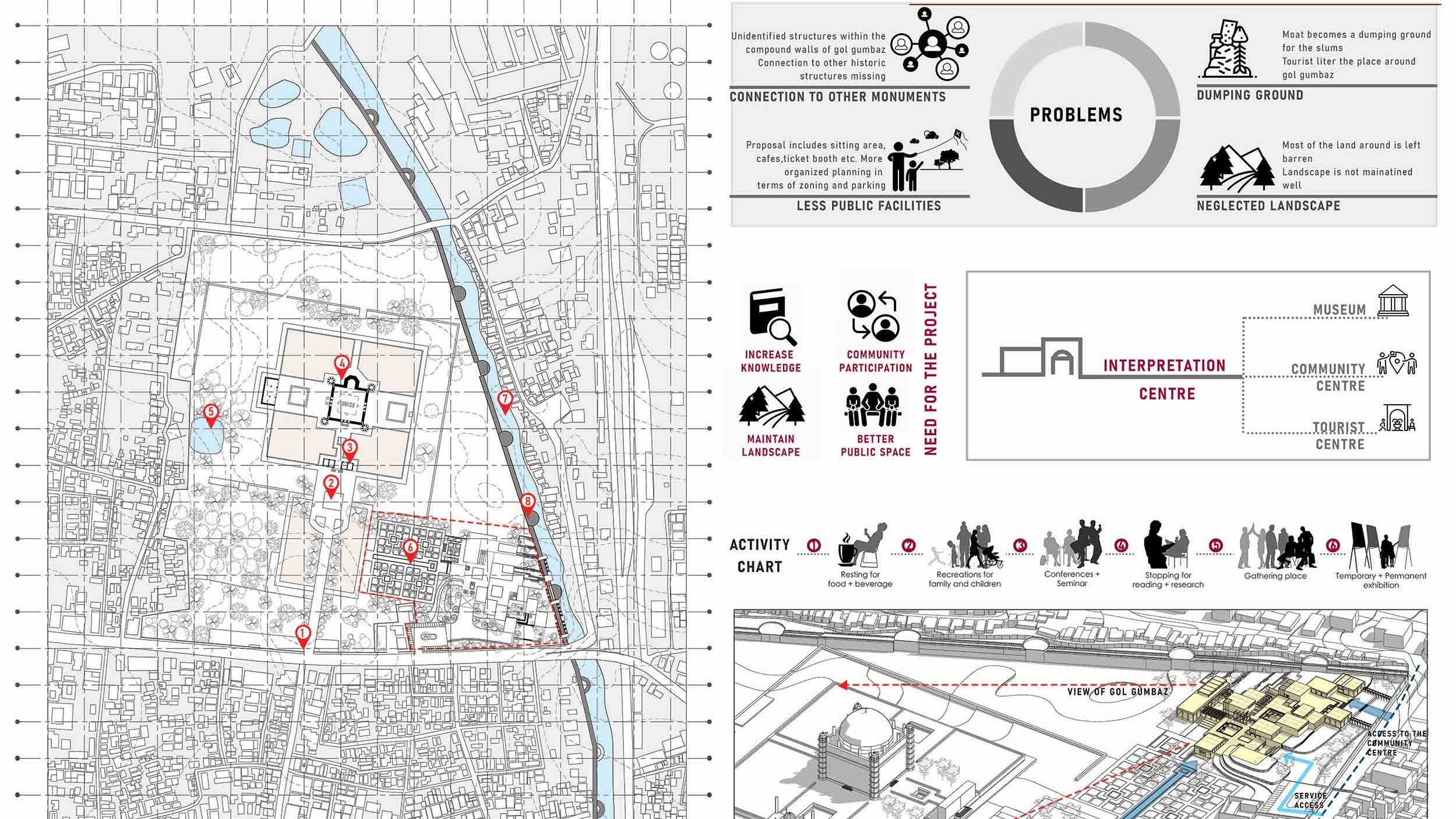top architecture design thesis 2020


GOA COLLEGE OF ARCHITECTURE
GOA, INDIA

Design thesis authored by
NILOUFER SHAHAPUR
share
THESIS SPECIFICATIONS
Thesis Title : Interpretation Centre for Islamic Art and Architecture of the Deccan Sultanate
Location : Bijapur, India
Project type: Urban & Historical revitalization
Year of completion : 2020
Name of Thesis mentor: Ar Vishvesh Khandolkar and Ms Oriana Fernandez
Background
History brings with it, prodigious duty of preservation and knowledge. The response to the preservation makes something obsolete in present time. There has been constant debate between nihilistic and nostalgic approaches for preservation of past leading to petrification of the idea of time. The motivation for this thesis was an attempt to bridge the gap between this nihilistic and nostalgic thought by promoting knowledge and aggrandizing the tourism sector.
The site was chosen near Gol Gumbaz as it is the epitome of the Deccan heritage. On an average 2500 people visit Gol Gumbaz which is less than one tenth of the number of tourists that visit Taj Mahal. Therefore, it is important to enhance the experience of the users to increase the foot fall in Bijapur. The project is divided into three major segments– a tourist centre, a museum and a community centre which caters to both needs of tourist and local community. It helps in establishing a centre which aids the visitors in imbibing knowledge and provides public space to encourage social interactions and local community participation.
Design and Concept
The design of the building posed a challenge as it is situated close to Gol Gumbaz and therefore, could not overpower it in anyway. At the same time the urban grain of the surrounding context was very different from Gol Gumbaz which could not be overlooked. The building had to look unique yet form a balance between these two stark contexts. This project therefore was designed to be low lying and follow the urban grain of the surrounding context. It was envisioned such that when looked at from the Gol Gumbaz, it looked like it merged with the context at the background. And when viewed from the road it looked symbolic to Gol Gumbaz in its use of arches and basalt exterior finish. Therefore, forming a bridge between these two contextual elements at the same time respecting its own unique identity.
Each step of the project planning has been thought of in great depth, such as axis is planned based on the Islamic principles of axiality with a modern twist to it. Two different yet significant axes are established and overlayed to form a unique user experience. Courtyards are common features of some ancient houses in Bijapur which has been incorporated here. Galleries are designed to capture the view of Gol Gumbaz.
Water features used in a lot in Islamic architecture, is added on the ground floor along the pavilion to create an ambient public space for people to gather.
The ground floor is made porous with visible steel beam to give a rustic look to the building. Water feature and landscape add a colour pop to the otherwise rustic look of the project. The project has been explored in depth from site development to final finishes and along with an intervention for the degraded moat in the hope to replenish it.
The site is developed in a such a way that a large chunk of the museum gets hidden underground. To achieve that some part of the site is dug out so that the bigger part of the museum is hidden with the landscape and the smaller blocks are visible on the first floor. This helps in making the structure appear light and restrained with respect to the context. The building has two main access points; one on the ground is visually directed towards a small monument situated on the site and the other is a diagonal one which is visually directed towards the Gol Gumbaz which is the main highlight of the project. Courtyards are placed along these to axes to break the mass down and bring in light and ventilation. The whole project is laid on a 5X5m grid such that the ground floor has a relatively simpler planning, and the first floor even though has staggered blocks, still follows the same grid. Interaction between people using each space at a given time is perceived and designed in such a way that at any point from the courtyards, one can see the other courtyards as well as Gol Gumbaz.
As Bijapur has a very extreme climate, the windows were designed keeping in mind the amount of heat and light infiltration. North side facade has glass to bring in ambient light whereas the south side has smaller openings or slits to cut off the heat. Glass used is also dual pane which helps in cutting off the harsh sunlight. Terrace gardens are used to provide an ambient feature which also helps in regulating the temperature and keeping the place cool. The building is designed with courtyards and water bodies as it helps in lowering the temperature in addition to the aesthetic and symbolic reasons.
The building will be made of Steel frame structure with basalt cladding. Steel will be used as it is light weight and does not require deep foundation. Steel also helps creating long span structure which is apt for a museum. Use of basalt is symbolic as it is historically used in the monuments (even Gol Gumbaz is made of Basalt stone with lime stone plaster) and also because it is a locally available material with great thermal properties.
The project helps to fulfil the needs of the locals as well as tourist. It helps in providing knowledge about the art and architecture of the Deccan sultanate and thereby bringing awareness to the importance of site and surroundings. The intervention helps in replenishing the moat and increasing the usage of the fort wall as walkway. It also encourages community participation and development of lost forms of handicraft. This project is apt for the surrounding as it creates a bridge between the context and the Gol Gumbaz.
the end
Copyright information: ©️ Student author 2021. Prior written authorization required for use.
Request permissions: If you wish to use any part of the documentation forming part of the undergraduate thesis submitted to DSGN arcHive, please seek prior permission from the concerned student author through the respective college/university.
Exclusion of liability: DSGN arcHive and its owner do not undertake any obligation to verify the ownership of any content submitted for publication/broadcast on this website and shall not be liable for any infringement of copyright by, or unauthorized use of, such content.
HOMEPAGE
Copyright © 2025 DSGN arcHive
